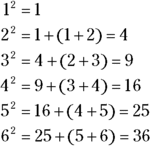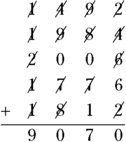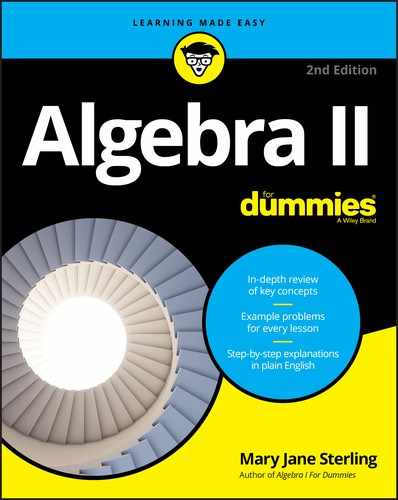Chapter 18
Ten Multiplication Tricks
IN THIS CHAPTER
![]() Saving time on tests and homework problems with fast multiplication
Saving time on tests and homework problems with fast multiplication
![]() Avoiding calculators and division (and sometimes multiplication itself)
Avoiding calculators and division (and sometimes multiplication itself)
You studied your multiplication tables way back in the third grade. You can quickly rattle off the product of 7 and 9 or 8 and 6 (can’t you?). In this chapter, you discover some new patterns and tricks to help you with products and processes — tricks that save you time. You’re also more apt to get the right answer when using these tricks (not that you ever have the wrong answer, of course). And think of how you can amaze your friends and colleagues by pulling seemingly tough answers out of thin air.
But before you get moving, I have a confession to make: I’ve snuck in an addition trick as well because I know that you’ll love it.
Squaring Numbers That End in 5
You know that 5 squared is 25. But what about ![]() , and so on? Don’t have your calculator on you? No worries. To square a number that ends in 5, follow these steps:
, and so on? Don’t have your calculator on you? No worries. To square a number that ends in 5, follow these steps:
Write down the last digits of the answer: 25.
The squared form of a number that ends in 5 always ends with 25.
- Take the digit or digits in front of the original 5 and multiply them by the next bigger number.
- Put the product of Step 2 in front of the 25, and you have the square of the number you want.
To square 35, for example, you write down the last two digits, 25. Now you multiply the 3 times the next bigger number, 4, to get 12. Put the 12 in front of the 25, and you have your answer: ![]() . Squaring 65, you know that
. Squaring 65, you know that ![]() , so
, so ![]() .
.
This trick even works with three-digit numbers. You find the square of 105 by multiplying ![]() , giving you
, giving you ![]() .
.
Finding the Next Perfect Square
In the previous section, you discover how to find the squares of numbers that end in 5. But what about all the other squares? A very nice property you can use deals with the next square in any list of the squares of whole numbers. The property states that you can get to the next square in the list by taking the square of the number you already have and adding the root plus the next number (the root of the square you want).
Look at a listing of the first six squares and how this works:

For example, if you know that ![]() , and you want
, and you want ![]() , you just add
, you just add ![]() (the next highest number), which equals
(the next highest number), which equals ![]() . To find the square of 81, you take
. To find the square of 81, you take ![]() and then add up the ingredients:
and then add up the ingredients: ![]() .
.
Recognizing the Pattern in Multiples of 9 and 11
Have you ever noticed something special about the first ten multiples of 9? Here’s the list (notice that I’ve made the first multiple into a two-digit number): 09, 18, 27, 36, 45, 54, 63, 72, 81, 90. Each of the multiples has two digits that add up to 9. Also, the first digit of each multiple is one less than its multiplier. So, when multiplying 7 times 9, you can start with one digit smaller than 7, the number 6. To find the sum, you take ![]() . The product of 7 and 9 is 63.
. The product of 7 and 9 is 63.
The number 11 has one pattern for two-digit numbers and another pattern for three-digit numbers. The pattern for two-digit numbers isn’t all that exciting. You already recognize 11, 22, 33, 44, and so on. Those are easy. But what about 110, 121, 143, 154, 165, 176, 187, and 198? Do you notice that the first and third digits add up to the middle digit? Now you know!
Casting Out 9s
A wonderful way to do a quick check of your addition or multiplication is to cast out 9s. The easiest way to explain this method is to demonstrate it (I start with the rogue addition trick I shoehorn into this chapter).
Assume that you have to add the following column of numbers, and you want to check your work without having to add again (many people don’t catch their errors by adding again because they make the same error again — it gets embedded in the mind):
To check your work, you look at all the digits in the numbers you’re adding. Start by crossing out (casting out) all the 9s. And don’t stop there! You can cast out sets of numbers that add up to 9 — the 1 and 8 in the second value and the 1 and 8 in the fifth value. You can also cross out the 2 and 6 in the third value and the 1 in the fourth value:

Now cross out the 1, 4, and 4 in the first and second values. Cross out the 2 and 7 in the first and fourth values and the 7 and 2 in the fourth and fifth values:

What do you have left? Not much! Add any digits you haven’t crossed out. You get ![]() . If the sum you find is bigger than 9, you add the digits of that sum (and then add that sum if it’s bigger than 9).
. If the sum you find is bigger than 9, you add the digits of that sum (and then add that sum if it’s bigger than 9).
Now look at the answer in the addition problem. Cross out the 9, and you have 7 left. That matches the 7 from the digits you find in your check. The sum checks out because they match.
Casting Out 9s: The Multiplication Moves
The previous section shows you how to cast out 9s for addition; here’s how you cast out 9s in a multiplication problem. You cross out 9s or sums of 9s in the first number. (If you can’t cross out any, add up the digits. If the sum is bigger than 9, add those digits.) Do the same with the second number. Repeat the process again with the answer. Here’s an example:

In the first number, you cast out the sum of 9 (the ![]() ) and then add the two remaining digits (
) and then add the two remaining digits (![]() to get 6). In the second number, you add the digits for a sum of 20. You then add those digits
to get 6). In the second number, you add the digits for a sum of 20. You then add those digits ![]() for a sum of 2.
for a sum of 2.
In the answer, you find two sets of digits that sum to ![]() . After crossing them out, you add the remaining digits and then their sum
. After crossing them out, you add the remaining digits and then their sum ![]() .
.
You finish by multiplying the sum of 6 from the first number by the 2 from the second number in the multiplication problem to get a product of 12. Add those two digits to get 3. That 3 matches the 3 in the digits from the answer. The answer checks out.
Multiplying by 11
Multiplying single digits, such as 3 or 6, by 11 is simple, in-your-head math. You just take the single digit, make two of them, and you’re done. So 3 times 11 is 33, and 6 times 11 is 66. So easy! Multiplying a larger number times 11 is a bit trickier. However, you can make it almost as easy as multiplying by one digit by just bookending the larger number with zeros and adding adjacent digits.
For instance, when multiplying ![]() , you put a zero in front of the first digit and a zero behind the last digit, and find the sum of each pair of adjacent digits. Using the modified original number, 01423270, you want the following sums:
, you put a zero in front of the first digit and a zero behind the last digit, and find the sum of each pair of adjacent digits. Using the modified original number, 01423270, you want the following sums:
The sums are 1, 5, 6, 5, 5, 9, and 7, so the product of ![]() is 1,565,597.
is 1,565,597.
For instance, when multiplying ![]() , you write it as 0564290 and add the following:
, you write it as 0564290 and add the following:
The sums are 5, 11, 10, 6, 11, and 9. Starting at the right end of the answer, you see that the last digit is 9. Now follow these steps:
- Write down the 9 as the right-most number.

- Write down the 1 from the ones place of the 11 in front of the 9, and carry the other 1 over to the
 .
.

- Add the
 .
.

- Adding
 , write down the 0 in front of the 7, and carry the 1 over to the left, adding it to the
, write down the 0 in front of the 7, and carry the 1 over to the left, adding it to the  .
.

Adding the 1 to the 11 gives you 12.
- Write down the 2 in front of the 0, and carry the 1 in the tens place over to the
 .
.

- Add the
 .
.

You now have 620,719.
So, ![]() .
.
Multiplying by 5
To multiply any number by five in your head, you can just halve the number you want to multiply and add a zero to the end of the number.
To multiply ![]() , for example, you take half of 14, which is 7, and put a 0 after the 7 —
, for example, you take half of 14, which is 7, and put a 0 after the 7 — ![]() .
.
But what if the number you want to multiply is odd and halving gives you a decimal? In this case, you don’t add a zero to the end of the halved number; you just drop the decimal point.
For example, if you want to multiply ![]() , you take half of 43, which is 21.5. Dropping the decimal point, you get 215 —
, you take half of 43, which is 21.5. Dropping the decimal point, you get 215 — ![]() .
.
This comes in really handy when you’re figuring tips. Now, I’m a 20 percent person — always grateful to be waited on by someone else. But sometimes it’s more appropriate to give a 15-percent tip. To figure a 15-percent tip on a bill totaling $70, you first compute the 10 percent (that’s easy — just move the decimal place and you get $7). Then compute the 5 percent by taking half of 7 and getting 3.5. Add the $3.50 to $7, and your 15-percent tip is $10.50. (But it’s still easier to figure 20 percent.)
Finding Common Denominators
When adding or subtracting fractions, you need a common denominator. In the problem ![]() , for example, the common denominator should be the least common multiple of 16 and 24 (the smallest number that they both divide into evenly). The proper way to find the least common denominator is to find the prime factorizations of the two denominators and build a common multiple from the factors.
, for example, the common denominator should be the least common multiple of 16 and 24 (the smallest number that they both divide into evenly). The proper way to find the least common denominator is to find the prime factorizations of the two denominators and build a common multiple from the factors.
But a quick, down-and-dirty way to find the common denominator of two fractions is to take the larger of the two denominators and check its multiples to see if the other denominator divides them evenly. In this case, you use the 24 and start at ![]() . The number 16 divides 48 evenly
. The number 16 divides 48 evenly ![]() , so 48 is the common denominator.
, so 48 is the common denominator.
When subtracting the fractions ![]() , you want the least common multiple of 15 and 20. Using the larger denominator, you try
, you want the least common multiple of 15 and 20. Using the larger denominator, you try ![]() , which is 40. But 15 doesn’t divide 40 evenly. You try
, which is 40. But 15 doesn’t divide 40 evenly. You try ![]() , and you get 60. This time you have a winner; 15 divides 60 evenly
, and you get 60. This time you have a winner; 15 divides 60 evenly ![]() .
.
Granted, you can always find a common denominator by multiplying the two denominators together, but that usually gives you a larger-than-necessary number that creates bigger numerators to perform operations on, and then results that have to be reduced.
Determining Divisors
When reducing fractions or factoring numbers out of terms in an expression, you want the largest number that divides two different numbers evenly. For instance, if you want to reduce the fraction ![]() , you want to find the largest number that divides both the numerator and denominator evenly. You know that two divides both because they’re even numbers. But you should aim to reduce only once, so you want the GCD: the greatest common divisor.
, you want to find the largest number that divides both the numerator and denominator evenly. You know that two divides both because they’re even numbers. But you should aim to reduce only once, so you want the GCD: the greatest common divisor.
To find the GCD, follow these steps:
Divide the smaller number into the larger number and check out the remainder.
For the previous example,
 with R 12 (the remainder is 12).
with R 12 (the remainder is 12).Divide the smaller number by the remainder.
You find that
 , with R 0. You find no remainder, so the divisor — the 12 — is the GCD. The reduced fraction is
, with R 0. You find no remainder, so the divisor — the 12 — is the GCD. The reduced fraction is  .
.
Other problems may involve more steps. To reduce the fraction ![]() , you find the GCD of the numbers 20 and 28: You find
, you find the GCD of the numbers 20 and 28: You find ![]() with R 8. Now you divide the 20 by the 8:
with R 8. Now you divide the 20 by the 8: ![]() with R 4. You divide the 8 by the remainder:
with R 4. You divide the 8 by the remainder: ![]() with R 0. When you get a remainder of zero, the last number you divided by is the GCD. The 4 divides 20 and 28 evenly:
with R 0. When you get a remainder of zero, the last number you divided by is the GCD. The 4 divides 20 and 28 evenly: ![]() .
.
Multiplying Two-Digit Numbers
To multiply two 2-digit numbers in your head, you can use the FOIL method (First, Outer, Inner, Last; see Chapter 1). Actually, you’ll use the LIOF method (lee-off?), changing the order of multiplication a bit.
For instance, to multiply ![]() , do the Last portion first by multiplying the 3 times the 2. Put a 6 in the right-most answer position.
, do the Last portion first by multiplying the 3 times the 2. Put a 6 in the right-most answer position.

Now you cross-multiply. The 4 in 43 times the 2 in 12 is 8. You add that value to the value for 3 times 1, and you get 11, the Outer and Inner portion. Put the 1 in the one’s place of 11 in front of the 6 for the answer and “carry” the other 1.

Now you multiply the 4 in 43 by the 1 in 12. Add the carried 1 to 4 and put the 5 in front of the 1 and 6 for a complete answer: 516.

This approach just takes a little practice. I find it to be a wonderful exercise to practice these problems when you’re at a boring meeting and need to make it look like you’re taking notes.

 This check isn’t foolproof. If you make an error that differs by 9 from the correct answer, you won’t catch your mistake. However, the ease and quickness of this method make up for that potential failure.
This check isn’t foolproof. If you make an error that differs by 9 from the correct answer, you won’t catch your mistake. However, the ease and quickness of this method make up for that potential failure. In the previous product, you see no carry-over. If one or more of the sums you find is greater than nine, you carry the tens digit over to the sum to the left of the digit in question.
In the previous product, you see no carry-over. If one or more of the sums you find is greater than nine, you carry the tens digit over to the sum to the left of the digit in question.